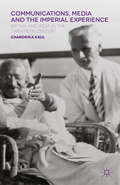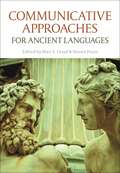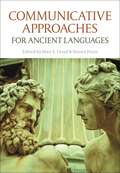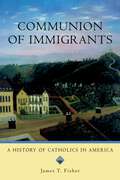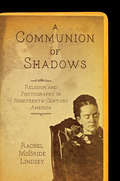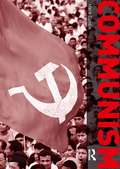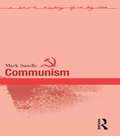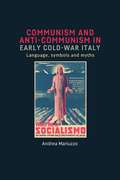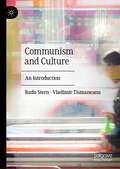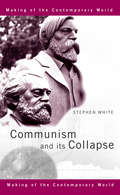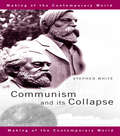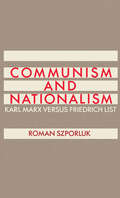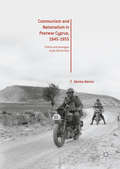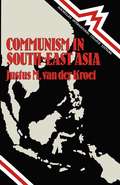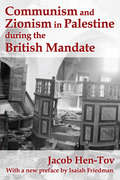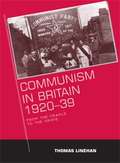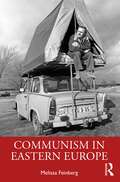- Table View
- List View
Communications, Media and the Imperial Experience: Britain and India in the Twentieth Century
by Chandrika KaulPresenting a communicational perspective on the British empire in India during the 20th century, the book seeks to examine how, and explain why, British proconsuls, civil servants and even the monarch George V, as well as Indian nationalists, interacted with the media, primarily British and American, and with what consequences.
Communicative Approaches for Ancient Languages
by Mair E. Lloyd and Steven HuntThis book is the first in its field. It showcases current and emerging communicative practices in the teaching and learning of ancient languages (Latin and Greek) across contemporary education in the US, the UK, South America and continental Europe. In all these parts of the globe, communicative approaches are increasingly being accepted as showing benefits for learners in school, university and college classrooms, as well as at specialist conferences which allow for total immersion in an ancient language. These approaches are characterised by interaction with others using the ancient language. They may include various means and modalities such as face-to-face conversations and written communication. The ultimate aim is to optimise the facility to read such languages with comprehension and engagement.The examples showcased in this volume provide readers with a vital survey of the most current issues in communicative language teaching, helping them to explore and consider adoption of a wider range of pedagogical practices, and encouraging them to develop tools to promote engagement and retention of a wider variety of students than currently find ancient languages accessible. Both new and experienced teachers and learners can build on the experiences and ideas in this volume to explore the value of these approaches in their own classrooms.
Communicative Approaches for Ancient Languages
This book is the first in its field. It showcases current and emerging communicative practices in the teaching and learning of ancient languages (Latin and Greek) across contemporary education in the US, the UK, South America and continental Europe. In all these parts of the globe, communicative approaches are increasingly being accepted as showing benefits for learners in school, university and college classrooms, as well as at specialist conferences which allow for total immersion in an ancient language. These approaches are characterised by interaction with others using the ancient language. They may include various means and modalities such as face-to-face conversations and written communication. The ultimate aim is to optimise the facility to read such languages with comprehension and engagement.The examples showcased in this volume provide readers with a vital survey of the most current issues in communicative language teaching, helping them to explore and consider adoption of a wider range of pedagogical practices, and encouraging them to develop tools to promote engagement and retention of a wider variety of students than currently find ancient languages accessible. Both new and experienced teachers and learners can build on the experiences and ideas in this volume to explore the value of these approaches in their own classrooms.
Communion of Immigrants: A History of Catholics in America (Religion in American Life)
by James T. FisherCatholicism has grown from a suppressed and persecuted outsiders' religion in the American colonies to become the nation's single largest denomination. James Fisher surveys more than four centuries of Catholics' involvement in American history, starting his narrative with one of the first Spanish expeditions to Florida, in 1528. He follows the transformation of Catholicism into one of America's most culturally and ethnically diverse religions, including the English Catholics' early settlement in Maryland, the Spanish missions to the Native Americans, the Irish and German poor who came in search of work and farmland, the proliferation of Polish and Italian communities, and the growing influx of Catholics from Latin America. The book discusses Catholic involvement in politics and conflict, from New York's Tammany Hall to the Vietnam War and abortion. Fisher highlights the critical role of women in American Catholicism--from St. Elizabeth Seton and Dorothy Day to Mother Cabrini, the first American citizen to be canonized a saint--and describes the influence of prominent American Catholics such as Cardinal John J. O'Connor, 1930s radio personality Father Charles Coughlin, President John F. Kennedy, pacifists Daniel and Philip Berrigan, activist Cesar Chavez, and author Flannery O'Connor. For this new edition, Fisher has brought the story up to date, including the latest struggles within the American church leadership.
Communion of Immigrants: A History of Catholics in America (Religion in American Life)
by James T. FisherCatholicism has grown from a suppressed and persecuted outsiders' religion in the American colonies to become the nation's single largest denomination. James Fisher surveys more than four centuries of Catholics' involvement in American history, starting his narrative with one of the first Spanish expeditions to Florida, in 1528. He follows the transformation of Catholicism into one of America's most culturally and ethnically diverse religions, including the English Catholics' early settlement in Maryland, the Spanish missions to the Native Americans, the Irish and German poor who came in search of work and farmland, the proliferation of Polish and Italian communities, and the growing influx of Catholics from Latin America. The book discusses Catholic involvement in politics and conflict, from New York's Tammany Hall to the Vietnam War and abortion. Fisher highlights the critical role of women in American Catholicism--from St. Elizabeth Seton and Dorothy Day to Mother Cabrini, the first American citizen to be canonized a saint--and describes the influence of prominent American Catholics such as Cardinal John J. O'Connor, 1930s radio personality Father Charles Coughlin, President John F. Kennedy, pacifists Daniel and Philip Berrigan, activist Cesar Chavez, and author Flannery O'Connor. For this new edition, Fisher has brought the story up to date, including the latest struggles within the American church leadership.
A Communion of Shadows: Religion and Photography in Nineteenth-Century America
by Rachel McBride LindseyWhen the revolutionary technology of photography erupted in American culture in 1839, it swiftly became, in the day's parlance, a "mania." This richly illustrated book positions vernacular photography at the center of the study of nineteenth-century American religious life. As an empirical tool, photography captured many of the signal scenes of American life, from the gold rush to the bloody battlefields of the Civil War. But photographs did not simply display neutral records of people, places, and things; rather, commonplace photographs became inscribed with spiritual meaning, disclosing, not merely signifying, a power that lay beyond.Rachel McBride Lindsey demonstrates that what people beheld when they looked at a photograph had as much to do with what lay outside the frame--theological expectations, for example--as with what the camera had recorded. Whether studio portraits tucked into Bibles, postmortem portraits with locks of hair attached, "spirit" photography, stereographs of the Holy Land, or magic lanterns used in biblical instruction, photographs were curated, beheld, displayed, and valued as physical artifacts that functioned both as relics and as icons of religious practice. Lindsey's interpretation of "vernacular" as an analytic introduces a way to consider anew the cultural, social, and material reach of religion.A multimedia collaboration with MAVCOR—Center for the Study of Material & Visual Cultures of Religion—at Yale University.
Communism
by Mark SandleWhy did communism grow so quickly? Why did it spread to turn almost half of the world red by the mid-1970s? What impact did it have upon capitalism and capitalist society?Communism is a concise introduction to one of the most important and influential movements of the 20th century. It shows how the modern communist movement emerged out of radical millenarian movements of the Middle Ages and the English Civil War, becoming a mass movement of industrial society, seeking to overturn capitalism and replace it with a society of equality, justice, harmony and co-operation. It traces the growth of modern communism from its beginnings in the early nineteenth century to its position of global power at the end of the Second World War. Mark Sandle investigates the ultimate failure of communism as a political ideology, and concludes by asking how far the historical record of communism has been used to conceal the historical record of capitalism.Ideal for courses in both History and Politics.
Communism
by Mark SandleWhy did communism grow so quickly? Why did it spread to turn almost half of the world red by the mid-1970s? What impact did it have upon capitalism and capitalist society?Communism is a concise introduction to one of the most important and influential movements of the 20th century. It shows how the modern communist movement emerged out of radical millenarian movements of the Middle Ages and the English Civil War, becoming a mass movement of industrial society, seeking to overturn capitalism and replace it with a society of equality, justice, harmony and co-operation. It traces the growth of modern communism from its beginnings in the early nineteenth century to its position of global power at the end of the Second World War. Mark Sandle investigates the ultimate failure of communism as a political ideology, and concludes by asking how far the historical record of communism has been used to conceal the historical record of capitalism.Ideal for courses in both History and Politics.
Communism
by Mark SandleThe twentieth century cannot be properly understood unless we understand communism: its origins, growth, demise and legacy. This brief overview of the history of communism challenges us to think about its role in shaping the contemporary world. This book shows how the modern communist movement emerged out of radical millenarian movements of the Middle Ages and the English Civil War, becoming a mass movement of industrial society, seeking to overturn capitalism and replace it with a society of equality, justice, harmony and co-operation. It traces the growth of modern communism from its beginnings in the early nineteenth century to its position of global power at the end of the Second World War. Why did communism grow so quickly? Why did it spread to turn almost half of the world red by the mid-1970s? What impact did it have upon capitalism and capitalist society?
Communism
by Mark SandleThe twentieth century cannot be properly understood unless we understand communism: its origins, growth, demise and legacy. This brief overview of the history of communism challenges us to think about its role in shaping the contemporary world. This book shows how the modern communist movement emerged out of radical millenarian movements of the Middle Ages and the English Civil War, becoming a mass movement of industrial society, seeking to overturn capitalism and replace it with a society of equality, justice, harmony and co-operation. It traces the growth of modern communism from its beginnings in the early nineteenth century to its position of global power at the end of the Second World War. Why did communism grow so quickly? Why did it spread to turn almost half of the world red by the mid-1970s? What impact did it have upon capitalism and capitalist society?
Communism and anti-Communism in early Cold War Italy: Language, symbols and myths (G - Reference, Information and Interdisciplinary Subjects)
by Andrea MariuzzoThe struggle in projects, ideas and symbols between the strongest Communist Party in the West and an anti-communist and pro-Western government coalition was the most peculiar founding element of Italian democratic political system after World War II. Communism and anti-Communism in early Cold War Italy enlightens new aspects of and players of the anti-Communist ‘front’. It takes into account the role of cultural associations, newspapers and the popular press in the selection and diffusion of critical judgements and images of Communism, highlighting a dimension that explains the force and the diffusion of anti-communist opinions in Italy after 1989 and the crisis of traditional parties. The author also places the case of Italian cold-war anti-communism in an international context for the first time.
Communism and anti-Communism in early Cold War Italy: Language, symbols and myths
by Andrea MariuzzoThe struggle in projects, ideas and symbols between the strongest Communist Party in the West and an anti-communist and pro-Western government coalition was the most peculiar founding element of Italian democratic political system after World War II. Communism and anti-Communism in early Cold War Italy enlightens new aspects of and players of the anti-Communist ‘front’. It takes into account the role of cultural associations, newspapers and the popular press in the selection and diffusion of critical judgements and images of Communism, highlighting a dimension that explains the force and the diffusion of anti-communist opinions in Italy after 1989 and the crisis of traditional parties. The author also places the case of Italian cold-war anti-communism in an international context for the first time.
Communism and Culture: An Introduction
by Vladimir Tismaneanu Radu SternThis book is a comprehensive introduction to the relationship between communism (understood as an ideological, political, and social project) and culture, broadly defined as the field of aesthetic production. Communism was a global phenomenon, and the global civil war of the 20th century was, in more than one respect, a cultural war, which involved some of the most influential figures of the last century. The book highlights and explains the impact of political mythologies in the effiorts to transcend the “bourgeois” legacies and engage in a social, cultural, and anthropological revolution. The authors examine the interplay between utopian goals and cultural practices in fields such as literature, visual arts, film, and humanities in general.
Communism And Its Collapse (The\making Of The Contemporary World Series )
by Stephen WhiteRanging from the Russian revolution of 1917 to the collapse of Eastern Europe in the 1980s this study examines Communist rule. By focusing primarily on the USSR and Eastern Europe Stephen White covers the major topics and issues affecting these countries, including: * communism as a doctrine * the evolution of Communist rule * the challenges to Soviet authority in Hungary and Yugoslavia * the emerging economic fragility of the 1960s * the complex process of collapse in the 1980s. Any student or scholar of European history will find this an essential addition to their reading list.
Communism And Its Collapse (The\making Of The Contemporary World Series )
by Stephen WhiteRanging from the Russian revolution of 1917 to the collapse of Eastern Europe in the 1980s this study examines Communist rule. By focusing primarily on the USSR and Eastern Europe Stephen White covers the major topics and issues affecting these countries, including: * communism as a doctrine * the evolution of Communist rule * the challenges to Soviet authority in Hungary and Yugoslavia * the emerging economic fragility of the 1960s * the complex process of collapse in the 1980s. Any student or scholar of European history will find this an essential addition to their reading list.
Communism and its Collapse (The Making of the Contemporary World)
by Stephen WhiteRanging from the Russian revolution of 1917 to the collapse of Eastern Europe in the 1980s this study examines Communist rule. By focusing primarily on the USSR and Eastern Europe Stephen White covers the major topics and issues affecting these countries, including:* communism as a doctrine* the evolution of Communist rule* the challenges to Soviet authority in Hungary and Yugoslavia* the emerging economic fragility of the 1960s* the complex process of collapse in the 1980s. Any student or scholar of European history will find this an essential addition to their reading list.
Communism and its Collapse (The Making of the Contemporary World)
by Stephen WhiteRanging from the Russian revolution of 1917 to the collapse of Eastern Europe in the 1980s this study examines Communist rule. By focusing primarily on the USSR and Eastern Europe Stephen White covers the major topics and issues affecting these countries, including:* communism as a doctrine* the evolution of Communist rule* the challenges to Soviet authority in Hungary and Yugoslavia* the emerging economic fragility of the 1960s* the complex process of collapse in the 1980s. Any student or scholar of European history will find this an essential addition to their reading list.
Communism and Nationalism: Karl Marx Versus Friedrich List
by Roman SzporlukIn this highly original study, Roman Szporluk examines the relationship between the two dominant ideologies of the 19th century--communism and nationalism--and their enduring legacy in the 20th century. Szporluk argues that both Karl Marx's theory of communism and Friedrich List's theory of nationalism arose in response to the sweeping changes brought about by the Industrial Revolution, and that both sought to promote industrialization as a means of reforming the modern world. Each ideology, the author contends, developed in relation to the other and can best be understood as the product of a complex interweaving of the two, producing in the 20th century new forms of nationalism that have incorporated Marxism into the fabric of their movement and Marxist states that have adopted threads of nationalistic belief. Casting the role of List and the intellectual development of Marx in an unorthodox light, this book adds a new dimension to the debate over the boundaries of nationalism and socialism in the development of political ideologies.
Communism and Nationalism in Postwar Cyprus, 1945-1955: Politics and Ideologies Under British Rule
by Alexios AlecouThis book analyzes the events that impacted the structure and competitive processes of the two dominant Cypriot political factions while under the watchful eye of British rule. Based on new archival research, Alecou addresses the social and political environment in which the Cypriot Communists and Nationalists fought each other while at the same time had to fight the British Empire. The differences between communists and nationalists brought the two sides to a frontal collision in the wake of the events of the Greek civil war. The class conflict within Cypriot society would at some point inevitably lead, in one way or another, to a clash between the two factions. The civil war in Greece constituted another field of conflict between Left and Right, accelerating the formation of a bipolar party system in which the vertical division of the Greek community in Cyprus eventually expressed itself.
Communism and Zionism in Palestine during the British Mandate
by Jacob Hen-TovThis reconstruction of Middle East politics and ideology focuses on the rise of the Zionist settlement in Palestine, the gradual emergence of Arab nationalism, and the increasing difficulties facing the British Mandatory government when reconciling the growing Arab-Jewish communal strife. The Communist International, searching for revolutionary situations in the underdeveloped world, attempted to use unrest in Palestine to undermine the Mandate. In the process two sections of the Communist movement were confronted with an expanding popular movement, Zionism, which they tried to suppress.The situation was unique. The Palestine Communist Party's leadership and membership were predominantly Jewish, and perceived the Communist International's anti-Zionist policies as a threat to the existence of the entire Jewish community. The Soviets themselves promoted an autonomous Jewish region within the Soviet Union and sought to combat manifestations of Zionism in the Middle East that might appeal to Russian Jewry.The precise mechanisms of control and policy influence that the Communist International exerted upon the Palestine Communist Party have only recently been revealed. The author's intimate knowledge of the Middle East enabled him to reconstruct the 1920s situation. By utilizing survivors' testimonies, he also was able to explain the roots of the strong anti-Israeli position taken by the Soviet Union at the time. Communism and Zionism in Palestine during the British Mandate is a vivid historical analysis and will be invaluable to those who wish to understand the complex present situation in the Middle East.
Communism and Zionism in Palestine during the British Mandate
by Jacob Hen-TovThis reconstruction of Middle East politics and ideology focuses on the rise of the Zionist settlement in Palestine, the gradual emergence of Arab nationalism, and the increasing difficulties facing the British Mandatory government when reconciling the growing Arab-Jewish communal strife. The Communist International, searching for revolutionary situations in the underdeveloped world, attempted to use unrest in Palestine to undermine the Mandate. In the process two sections of the Communist movement were confronted with an expanding popular movement, Zionism, which they tried to suppress.The situation was unique. The Palestine Communist Party's leadership and membership were predominantly Jewish, and perceived the Communist International's anti-Zionist policies as a threat to the existence of the entire Jewish community. The Soviets themselves promoted an autonomous Jewish region within the Soviet Union and sought to combat manifestations of Zionism in the Middle East that might appeal to Russian Jewry.The precise mechanisms of control and policy influence that the Communist International exerted upon the Palestine Communist Party have only recently been revealed. The author's intimate knowledge of the Middle East enabled him to reconstruct the 1920s situation. By utilizing survivors' testimonies, he also was able to explain the roots of the strong anti-Israeli position taken by the Soviet Union at the time. Communism and Zionism in Palestine during the British Mandate is a vivid historical analysis and will be invaluable to those who wish to understand the complex present situation in the Middle East.
Communism in Britain, 1920–39: From the cradle to the grave
by Thomas LinehanBased on extensive use of primary evidence, this book is a study of the British communist life between the Wars as it was experienced at the various phases of the life cycle.
Communism in Eastern Europe
by Melissa FeinbergCommunism in Eastern Europe is a ground-breaking new survey of the history of Eastern Europe since 1945. It examines how Communist governments came to Eastern Europe, how they changed their societies and the legacies that persisted after their fall. Written from the perspective of the 21st century, this book shows how Eastern Europe’s trajectory since 1989 fits into the longer history of its Communist past. Rather than focusing on high politics, Communism in Eastern Europe concentrates on the politics of daily life, melding political history with social, cultural and gender history. It tells the history of this complicated era through the voices and experiences of ordinary people. By focusing on the complex interactions of everyday life, Communism in Eastern Europe illuminates the world Communism made in Eastern Europe, its politics and culture, values and dreams, successes and failures. This book is an engaging introduction to the history of Communist Eastern Europe for any reader. It is ideal for adoption in a wide array of undergraduate and graduate courses in 20th century European history.
Communism in Eastern Europe
by Melissa FeinbergCommunism in Eastern Europe is a ground-breaking new survey of the history of Eastern Europe since 1945. It examines how Communist governments came to Eastern Europe, how they changed their societies and the legacies that persisted after their fall. Written from the perspective of the 21st century, this book shows how Eastern Europe’s trajectory since 1989 fits into the longer history of its Communist past. Rather than focusing on high politics, Communism in Eastern Europe concentrates on the politics of daily life, melding political history with social, cultural and gender history. It tells the history of this complicated era through the voices and experiences of ordinary people. By focusing on the complex interactions of everyday life, Communism in Eastern Europe illuminates the world Communism made in Eastern Europe, its politics and culture, values and dreams, successes and failures. This book is an engaging introduction to the history of Communist Eastern Europe for any reader. It is ideal for adoption in a wide array of undergraduate and graduate courses in 20th century European history.
